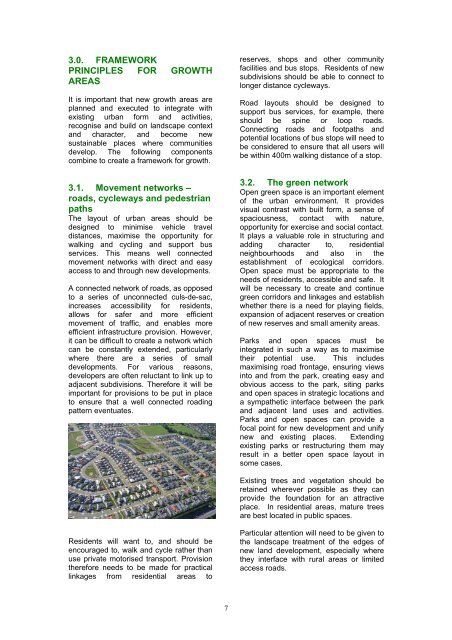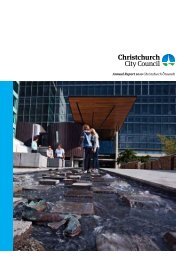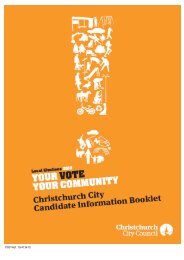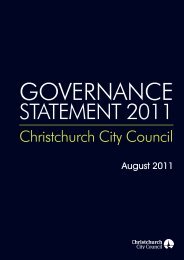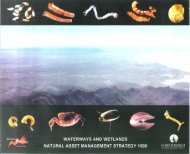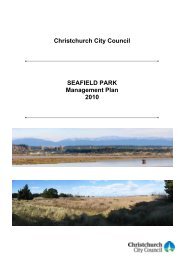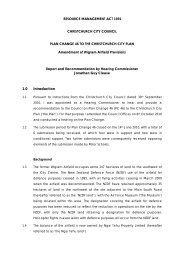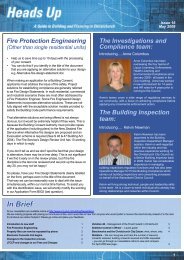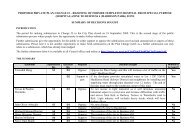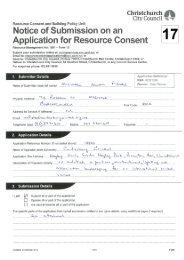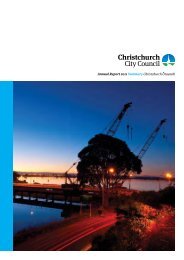Belfast Area Plan - Urban Design Study - Christchurch City Council
Belfast Area Plan - Urban Design Study - Christchurch City Council
Belfast Area Plan - Urban Design Study - Christchurch City Council
You also want an ePaper? Increase the reach of your titles
YUMPU automatically turns print PDFs into web optimized ePapers that Google loves.
3.0. FRAMEWORK<br />
PRINCIPLES FOR GROWTH<br />
AREAS<br />
It is important that new growth areas are<br />
planned and executed to integrate with<br />
existing urban form and activities,<br />
recognise and build on landscape context<br />
and character, and become new<br />
sustainable places where communities<br />
develop. The following components<br />
combine to create a framework for growth.<br />
3.1. Movement networks –<br />
roads, cycleways and pedestrian<br />
paths<br />
The layout of urban areas should be<br />
designed to minimise vehicle travel<br />
distances, maximise the opportunity for<br />
walking and cycling and support bus<br />
services. This means well connected<br />
movement networks with direct and easy<br />
access to and through new developments.<br />
A connected network of roads, as opposed<br />
to a series of unconnected culs-de-sac,<br />
increases accessibility for residents,<br />
allows for safer and more efficient<br />
movement of traffic, and enables more<br />
efficient infrastructure provision. However,<br />
it can be difficult to create a network which<br />
can be constantly extended, particularly<br />
where there are a series of small<br />
developments. For various reasons,<br />
developers are often reluctant to link up to<br />
adjacent subdivisions. Therefore it will be<br />
important for provisions to be put in place<br />
to ensure that a well connected roading<br />
pattern eventuates.<br />
reserves, shops and other community<br />
facilities and bus stops. Residents of new<br />
subdivisions should be able to connect to<br />
longer distance cycleways.<br />
Road layouts should be designed to<br />
support bus services, for example, there<br />
should be spine or loop roads.<br />
Connecting roads and footpaths and<br />
potential locations of bus stops will need to<br />
be considered to ensure that all users will<br />
be within 400m walking distance of a stop.<br />
3.2. The green network<br />
Open green space is an important element<br />
of the urban environment. It provides<br />
visual contrast with built form, a sense of<br />
spaciousness, contact with nature,<br />
opportunity for exercise and social contact.<br />
It plays a valuable role in structuring and<br />
adding character to, residential<br />
neighbourhoods and also in the<br />
establishment of ecological corridors.<br />
Open space must be appropriate to the<br />
needs of residents, accessible and safe. It<br />
will be necessary to create and continue<br />
green corridors and linkages and establish<br />
whether there is a need for playing fields,<br />
expansion of adjacent reserves or creation<br />
of new reserves and small amenity areas.<br />
Parks and open spaces must be<br />
integrated in such a way as to maximise<br />
their potential use. This includes<br />
maximising road frontage, ensuring views<br />
into and from the park, creating easy and<br />
obvious access to the park, siting parks<br />
and open spaces in strategic locations and<br />
a sympathetic interface between the park<br />
and adjacent land uses and activities.<br />
Parks and open spaces can provide a<br />
focal point for new development and unify<br />
new and existing places. Extending<br />
existing parks or restructuring them may<br />
result in a better open space layout in<br />
some cases.<br />
Existing trees and vegetation should be<br />
retained wherever possible as they can<br />
provide the foundation for an attractive<br />
place. In residential areas, mature trees<br />
are best located in public spaces.<br />
Residents will want to, and should be<br />
encouraged to, walk and cycle rather than<br />
use private motorised transport. Provision<br />
therefore needs to be made for practical<br />
linkages from residential areas to<br />
Particular attention will need to be given to<br />
the landscape treatment of the edges of<br />
new land development, especially where<br />
they interface with rural areas or limited<br />
access roads.<br />
7


